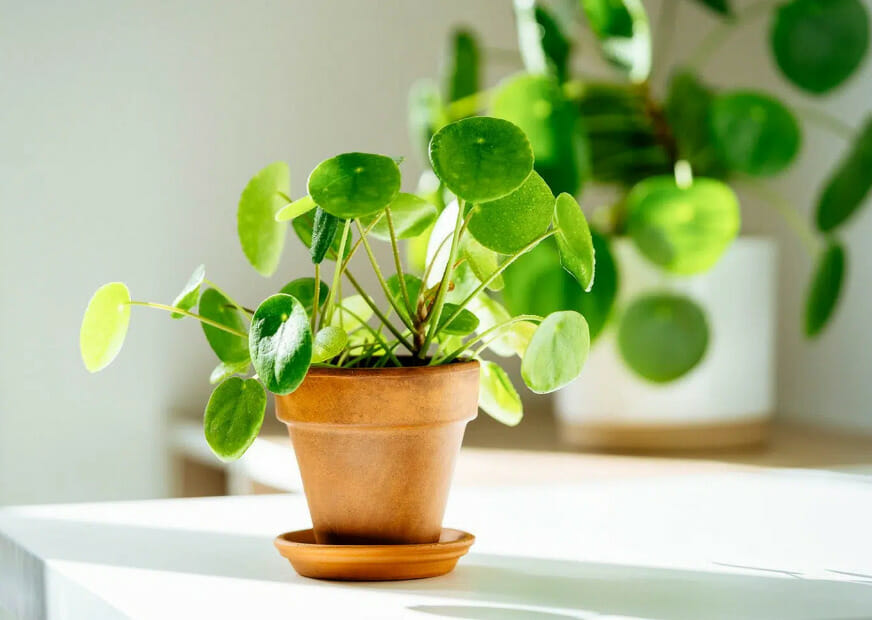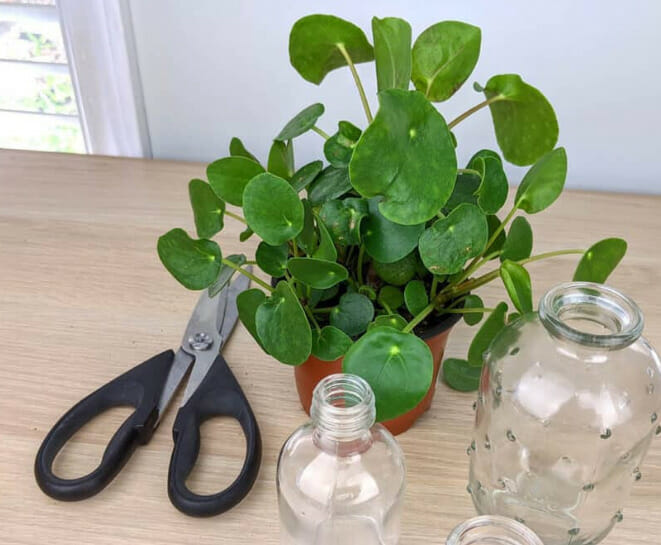Pilea Peperomioides, commonly known as the Chinese moneyplant, has grown in popularity as an indoor plant because of its beautiful appearance and ease of care. Few other indoor plants are as adaptable to the indoor environment as the Chinese moneyplant (Pilea Peperomioides). However, questions often arise about Chinese moneyplant care indoors. This houseplant can be placed in low-light areas and does not need extensive watering or fertilizing to survive and thrive.

If you’re looking for a low-maintenance indoor plant, the Chinese moneyplant may be perfect for you! While this plant’s proper name is Pilea Peperomioides, it’s also known as Pilea Mollis, Chinese Pilea, Rubber Plant, and The Philodendron relative. Let’s discuss how you can do Chinese Moneyplant Care Indoor.
1. Why the Chinese Moneyplant is the Perfect Indoor Plant?
When many people think of houseplants, the Chinese money plant probably isn’t the first thing that comes to mind. It’s not flashy or expensive like some other popular choices. Still, it has several advantages that make it an excellent choice for your home or office, and you can easily do Chinese Moneyplant Care Indoor without any challenges.
- Attractive leaves: The Chinese moneyplant is a tropical houseplant with narrow, oval-shaped leaves that are dark green and glossy. The leaves grow close to each of the three to four stems. The shiny round leaves look attractive, making a bold statement in your indoor space.
- Easy to grow: Chinese moneyplants are among some of the easiest to grow houseplants and some most beautiful and interesting. They need a lot of light, don’t require much water (2-3 times a week), and like high humidity. Keeping it in a container or saucer partially filled with pebbles or rocks will help keep it humid enough. With proper care, these plants can live for about 15 years!
- Air Purifier: Chinese money plants have the unusual ability to purify air quality. It can remove formaldehyde from the air. This plant is also moderately pet-friendly.
- Low maintenance: It is one of the most low-maintenance plants you can choose for your home or office. Place this exotic but hardy houseplant in a bright spot where it will get at least six hours of indirect sunlight each day. Water thoroughly when the top inch of soil feels dry, and let the excess water drain away from the roots. Trim off damaged leaves with clean pruning shears or scissors to maintain an attractive shape.
- Drought-tolerant: This plant is quite drought-tolerant and doesn’t require too much water. So, if you forget to water it for a week or two, it can survive easily.

2. Chinese Moneyplant Care Indoor:
Here are the best care tips for Chinese Moneyplant that will keep them fresh for a long:
2.1. Light Conditions:
The great thing about these plants is that they don’t need a lot of sunlight to survive. They will do well with just six hours a day of indirect light, which can be provided by artificial light sources such as LED lights or any lamps. Keep it in an area with indirect sunlight or under fluorescent lights for about 15 hours per day if you can control the amount of natural light your plant receives.
However, the amount of light your Pilea Peperomioides receives is important in how the plant performs indoors. The best places to place your Pilea Peperomioides are in bright, indirect light from a window or under artificial lights. You can supplement with fluorescent lights or grow lights if you cannot provide adequate sunlight.

2.2. Watering:
The Chinese money plant doesn’t like to be overwatered. Weekly watering sessions do fine. The Chinese money plant should be watered only when the top inch of soil is dry, so give it a little time before deciding whether or not you need to water your Pilea. Watering a Pilea when it is too moist can lead to an overwatering infection or root rot. During the winter season, you can water fortnightly.
2.3. Humidity:
The Chinese money plant requires moderate humidity to thrive, so you need to find a spot with higher moisture levels. Aim for a humidity level of 40-60%, which can be achieved by running your bathroom or kitchen sink for several minutes daily.
You may also want to use a humidifier in your plants’ room. If it is too dry, the leaves will start to turn brown and curl up. The leaves will grow moldy and go limp if it is too moist. To help control this balance, mist the leaves every couple of days or place them in an area with high air circulation (like near an open window).
2.4. Pruning the stems:
When you need to prune, be sure not to cut more than a third of the plant at one time. Don’t cut any leaves, and make sure you let them dry before watering them again. You can also propagate new plants by cutting the stems.

2.5. Potting Soil :
Always use the right potting soil or mix. You want a light, fast-draining mix that will not remain waterlogged over time. A mixture of bark chips, cedar chips, and coarse sand should work well. However, terracotta pots are a good choice for potting Chinese money plants as they allow the water to drain easily and the soil mix to dry quickly.
2.6. Fertilizer:
Chinese money plants don’t require too much fertilizer. During the growing season, you can feed regular fertilizer in diluted form. If your plant does have insect damage, you can use an insecticide like neem oil for effective control. Be sure to use a fast-drying material for fertilizer to avoid harming the plants. If fertilizing with a liquid form, dilute the solution 1:1 with water before applying. Give as directed on package instructions.
2.7. Avoid Overwatering
The Chinese money plant should be watered only when the top inch of soil is dry, so give it a little time before deciding whether or not you need to water your Pilea. A good rule is that if the plant starts wilting after being watered, you water it too much. Watering a Pilea when it is too moist can lead to an overwatering infection caused by the plant’s lack of ability to absorb water.

Other Care Tips:
- This plant doesn’t do well in shaded areas or near large glass windows, so keeping them out of any drafty area in your home or office is important.
- The leaves will generally turn yellow if the plant is not getting enough sunlight or water. In that case, you need to move it to a brighter location or provide more water until the leaves regain their green color.
- Leaves might also turn brown if insects eat, so monitor for any unusual pest attack.
- To avoid root rot, choose a medium-sized pot with many drainage holes for good drainage.
- Money plants make many babies, so propagation is an effective technique to increase your plants. Just take a stem cutting and put it in water.
- The best time to water your plants is when the top inch of the soil feels dry to the touch.
- To help keep your plant’s leaves looking their best, dust them weekly with a soft-bristled brush.

Related Article: How to Grow plants From Cuttings in Water? A Beginner’s Guide to Plant Propagation
Advantages of Pilea Peperomioides
- They are one of the best plants for beginners.
- They are small and space efficient.
- They don’t need a lot of light or water.
- They can survive in almost any environment.
- They grow much slower than other types of houseplants, making them ideal for those who have difficulty keeping up with their plants. – These plants also require very little attention.
- If you don’t want to see it anymore, just let it dry out, and it will die on its own.
- However, if you want to bring your money plant back to life, many YouTube videos will show you how!
Where to Buy the Chinese Money Plant
The Pilea Peperomioides is an attractive indoor plant that does well in just about any environment. They can grow into small shrubs or large trees. You may want to consider the size you want your plant to be before you start caring for it.
There are many places to buy this type of plant online, at your local grocery store, or even on Amazon! If you’re looking for a quick delivery option, I recommend checking out what’s available on Amazon Prime.
Conclusion
In conclusion, Pilea Peperomioides is an excellent indoor plant because it’s easy to care for, lasts a long time, and can grow in just about any light condition. The plant is also very hardy, meaning it will thrive in areas with high humidity and cold winter, needing water occasionally. Its small leaves make it perfect for houses with smaller windows and no plants on the balconies.
If you liked this article, visit our website for more articles on plants and planters.
